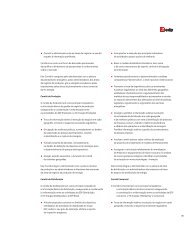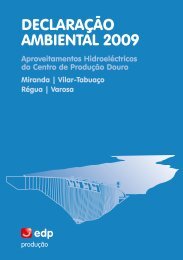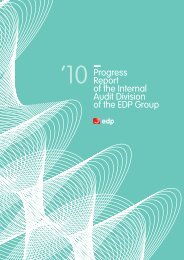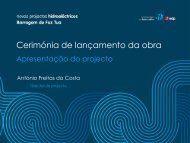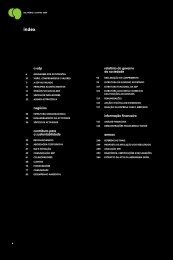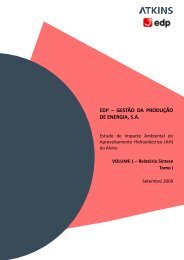Annual Report - EDP
Annual Report - EDP
Annual Report - EDP
- No tags were found...
You also want an ePaper? Increase the reach of your titles
YUMPU automatically turns print PDFs into web optimized ePapers that Google loves.
: performance :In Brazil, <strong>EDP</strong> has no generation operations inareas classified as nature reserves or protectionzones. Nevertheless, the location of the plants –particularly those in the Amazon Forest, AtlanticForest and Cerrado savannah biomes – requiresthat they be closely monitored due to theseareas’ acute ecological sensitivity. These last twobiomes are identified as biodiversity hotspots.Generation activityIn the generation activities in operation,biodiversity is globally approached in the contextof the environmental management systemsin place, with the focus on minimising andoffsetting impacts on biodiversity maintainedin the new generation plants in the design and/or construction phases, whether hydroelectricor wind energy. The following projects were ofparticular note in 2012 (see page 84 for moreinformation):º º Baixo Sabor Hydroelectric Power Plant, whichis located within a Natura 2000 reserve area.It features a wide range of impact minimisationand offsetting measures in an interventionin an area of over 1,200 ha that includes theplanting of holm oak and juniper woods andriparian vegetation, installing mosaics ofpasture and glades for deer, partridge andrabbit, and various actions to reduce the firerisk in priority habitats occupied areas. Theother measures to be implemented includethe reduction of human interference throughthe creation of non-hunting zones and animalrefuge zones in areas that are critical for theconservation of the wolf packs of Souto daVelha, Paradela, Alfândega da Fé and Talhinhas,and for the preservation of Bonelli’s Eagle andGolden Eagle, covering a total estimated areaof 5,800 ha;º º Foz Tua Hydroelectric Power Plant, the damfor this plant will affect a total area of 457 ha ofprotected habitats (for rare, endemic, localised,threatened animals or animals in danger ofextinction). In order to minimise and offset thisimpact, measures were developed to maintainor recover a total area of 686 ha with the sameclassification;º º One can also highlight the environmental careobserved in Venda Nova III and Salamonde II,namely in terms of the control and monitoringof the impact of the works on undergroundwater resources, as well as the developmentof an Integrated Acacia Control and HabitatRecovery Plan (in particular habitats inmixed woods, bogs and riparian galleries) inSalamonde and also the forestation plan tooffset the increase in capacity at Alqueva;º º Cachoeira Caldeirão Hydroelectric Power Plantin Brazil, for which the reservoir lake will floodabout 2,600 ha of land, including approximately10 ha of the urban area of the municipalityof Porto Grande and 1,161 ha of Amapá StateForest. The Environmental Impact Studymakes provisions for 20 socio-environmentalprogrammes to offset or mitigate the impacts,including. Among them, in the environmentalaspects: the monitoring of the riparian forestand species affected by the filling of the damreservoir and also the recovery of areasnegatively affected by the construction workon the power generation unit. These measuresare accompanied by financial compensation toaffected municipalities and measures of socialframework. During the licensing process,new compensatory measures are likely to bedecided.In Brazil, <strong>EDP</strong> has a total area of some 876 haearmarked for environmental recovery and/or<strong>EDP</strong> - <strong>Annual</strong> <strong>Report</strong> 2012offsetting measures in the surroundingsof its hydroelectric plants, of which 635 hahave already been recovered, keeping currentlymonitoring and replanting when necessary.These processes guarantee the use of localspecies without alteration of the habitat typeand are monitored by local authorities. Alsoin connection with these power plants, <strong>EDP</strong> isresponsible for maintenance of the areas aroundthe reservoir lake which have been classified asPermanent Preservation Areas; these areas totalapproximately 13,900 ha.The construction of wind farms occupies littlesurface area and one estimates that, in a typicalcase, less than 1% of the surface area ofa wind farm site is affected; this includes accessroutes and auxiliary facilities necessary foreffective management of the farm. The regularmonitoring practices and offsetting measuresare mostly implemented through partnershipswith environmental NGOs; these focus mainlyon bird and bat wildlife. The construction phaseis normally followed by a landscape recoveryprogramme of the site. In 2012 a total area of149.29 ha was recovered.<strong>EDP</strong> Distribuição launched its EnvironmentalPromotion Programme 2012, which includesthe National Specific Programme for Wild Birds.The programme has a budget of EUR 461,000and consists of three sub-projects: correctionof potentially dangerous power lines, with 18 kmof lines being corrected so far; interventions inwhite stork nests, with the transfer of some 100nests from dangerous locations; and continuationof the collaboration between <strong>EDP</strong> Distribuição,the Portuguese Society for the Study of Birds(SPEA), Quercus and the Institute for theConservation of Nature and Forests (ICNF) ina monitoring programme and other effectivenessassessment studies of measures taken.In Spain, HC Energía produced a Good PracticeManual for Management of Protection StripsAlongside Power Lines. The manual seeks toensure compatibility of the necessary safetymaintenance work with the habitats and speciesincluded in the Natura 2000 programme, thusensuring the protection of these eco-systems.3.4.4. waterWater is a fundamental resource for <strong>EDP</strong>operations. The company takes a strategic andoperational approach to the management ofwater. In 2012 <strong>EDP</strong> published a Corporate WaterManagement Policy that is aimed at promotingsustainability in water management, as wellas assessing the exposure of operations towater stress. This process applied the GlobalWater Tool, which was developed by the WorldBusiness Council for Sustainable Development.The conclusion was that the only <strong>EDP</strong> facilitylocated in an area that can currently be consideredto be subject to water stress is the Sierra deTercia cogeneration plant in Murcia, Spain, whichaccounts for approximately 0.07% of the Group’sinstalled capacity. This plant uses waste from thelocal pig farming industry, reducing that industry’sconsiderable environmental impact. The plant wasbuilt using the best water management processes,such as the reuse of condensate water fromeffluent treatment and the reuse of purge water toirrigate neighbouring fields.Water is used in the power generation processin thermal power plants primarily for coolingcircuits (99.4%). It is subsequently returned tothe environment at a slightly higher temperature.This process is periodically checked by the plants.The temperature of discharge water during2012 was within the limits set out in the variousenvironmental permits.65








